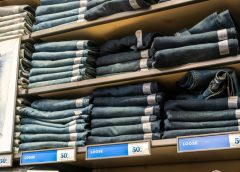
Apparel Sellers’ Fashion Emergency Must Be Handled With Care
[ad_1]
To sell or not to sell: That is the question inventory-stuffed apparel sellers find themselves asking lately.
Abercrombie & Fitch,
ANF -9.00%
which reported earnings last Thursday, said inventory rose 70% in its quarter ended July 30 compared with a year earlier.
Victoria’s Secret,
VSCO -3.19%
which also reported Thursday, saw merchandise levels swell 46% over the comparable period.
Gap
GPS -1.90%
and
Urban Outfitters
URBN -1.90%
said their inventories were up 37% and 44% in their latest quarters, respectively. The four apparel companies together are sitting on $1.7 billion more merchandise than they were a year earlier.
They can deal with that excess merchandise in one of three ways: bite the bullet and write it off now; discount it heavily; or pack it away in storage until next season, when consumer demand might return. In many cases, companies will use a mix of all three strategies, but the proportions will depend in large part on their diagnosis.
Many have blamed inflation and pinched wallets as a reason behind lackluster sales, an explanation that has some merit. At
Abercrombie & Fitch,
ANF -9.00%
the adult-focused namesake brand posted its highest second-quarter sales since 2015. What dragged its results down, though, was lackluster sales at Hollister, whose customer base tilts lower on the income scale. A similar segmentation was seen at Macy’s, where its namesake department store saw comparable-store sales decline 2.8%, while higher-end Bloomingdale’s recorded a 5.8% increase. Apparel sellers that think that is the main issue will lean more heavily on discounts and clearances.
But they might be leaving money on the table if the reason is simply that customers are overloaded on some wardrobe items. Casual, work-from-home clothes also were the types of items that currently underperforming brands such as Hollister, Old Navy and
Kohl’s
probably overstocked.
“Consumers didn’t fight prices on the way up. Companies shouldn’t expect them to jump on discounts on the other side,” notes Simeon Siegel, equity analyst at BMO Capital Markets.
If companies see that as the main culprit behind unsold piles of inventory, the sensible move would be to pack it away for later seasons when customers feel an itch to replace their wardrobe. That comes with its own baggage, of course. Holding inventory takes up storage and comes with the risk of inevitable write-downs if the chosen merchandise doesn’t resonate with customers in future seasons.
Still, that is a risk that may be worth taking for most apparel sellers, which will be dealing with some fierce price competition in the coming months. Companies that mentioned such a strategy included
Carter’s,
a children’s apparel company, and
Gap,
which said last Thursday that roughly 10 percentage points out of the 37% in the inventory growth was for pack and hold. Kohl’s said in its latest earnings call that roughly $82 million of its excess inventory included products it had packed away, such as sleepwear and fleece.
The inventory glut will leave no apparel seller unscathed, but companies making the right customer diagnosis today could come out looking sharper.
Write to Jinjoo Lee at jinjoo.lee@wsj.com
Copyright ©2022 Dow Jones & Company, Inc. All Rights Reserved. 87990cbe856818d5eddac44c7b1cdeb8
[ad_2]
Source link


